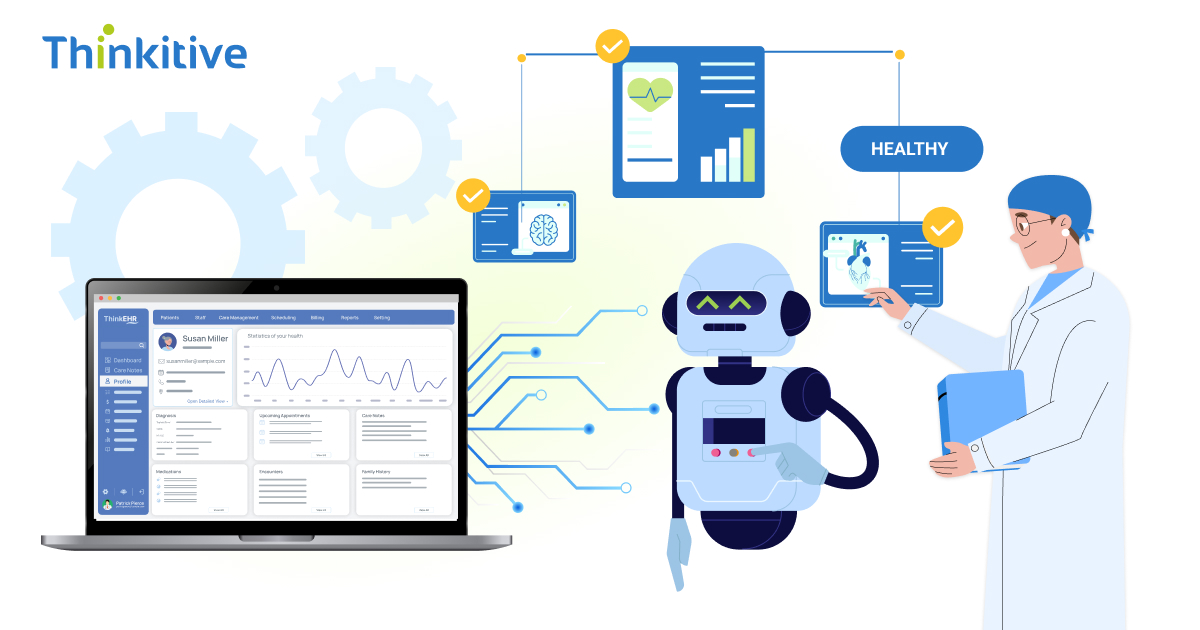Ever feel like even with EHR, your tasks seem endless and repetitive? Well, you are not alone. Most of the healthcare staff, especially administrators, put one-third of their time into doing manual and repetitive tasks.
But what if I tell you that you can stop doing the same tasks again and again?
For this to happen, you need to combine your EHR integration platform with healthcare Robotic Process Automation (RPA). Now, for many, the term Robotic Process Automation (RPA) may seem familiar, and for many, this is a completely new concept.
So, RPA is a technology that helps you automate tasks that do not need much human interaction or supervision by using software bots. This, when brought into healthcare and combined with EHR integration, can automate multiple tasks from administration to managing patient records.
The benefits of integrating healthcare RPA in your EHR software are many, as you get the healthcare staff’s focus back to patient care. The productivity of administrative staff skyrockets, and with automated documentation, the billing process is enhanced significantly.
However, before implementing healthcare RPA, you need to understand what it does exactly and the best strategies to make the most out of this opportunity. This is why we have given you everything you need to start the implementation, so let’s get to it without wasting your time!
Understanding Healthcare RPA: Beyond Simple Task Automation
Before diving into the implementation of Robotic Process Automation in your organization, let’s first understand what RPA is and how it helps you. In simple terms, they are the software bots that assume the role of a digital assistant that never stops working or makes mistakes, but works like a human does for certain tasks.
In a healthcare organization, these bots mimic human actions across systems like EHR, billing, and scheduling tools. As they are rule-based with specific instructions, they can carry out structured tasks such as patient data entry, claim submissions, and managing patient records. The best part is you don’t need to do a complete EHR overhaul, as RPA fits right into your existing ones.
However, what makes healthcare RPA truly valuable is its ability to work around the clock. This 24/7 availability reduces bottlenecks caused by staffing shortages or peak periods. Additionally, it is accurate in what it does, so manual errors in data entry or compliance reporting are completely eliminated.
Of course, healthcare RPA must comply with the rules, especially HIPAA. Thankfully, most solutions are designed with security and compliance in mind. They also understand healthcare workflows like clinical documentation, billing cycles, and payer regulations, making integration smoother.
Moreover, with healthcare RPA handling structured tasks, if paired with artificial intelligence (AI), it can open new doors. With AI, bots can even process unstructured data by using natural language processing (NLP) or support predictive decision-making through analytics.
Common Healthcare Tasks Prime for RPA Automation
Now, if you are wondering which tasks the RPA can do the best, and where its efficiency is at its highest, then those tasks are repetitive and rule-based ones. The first task where the RPA shines is patient registration. The RPA bots can pull patient data from pre-filled forms and put it into multiple systems like EHRs, scheduling systems, and billing platforms.
The duplicate entries and clerical errors are entirely eliminated. They can also verify the insurance eligibility, freeing up staff to focus on patient care. The second task is creating clinical documentation. Bots can auto-fill clinical forms from existing patient data, along with ensuring that lab results go to the right provider.
The next task at which it shines is most significant for healthcare organizations, as it is revenue and billing management. With its features like auto-claim submission, you don’t need to worry about submitting claims on time ever again. Moreover, with automated prior authorization, the request and approval process are streamlined, meaning patients get the care they need faster.
Finally, regulation management is no longer a headache you have to deal with every time. With automated data collection and report formatting, preparing detailed audit reports becomes precise and much easier.
EHR Integration Strategies for Maximum RPA Effectiveness
When it comes to getting the most out of Robotic Process Automation (RPA) in healthcare, a smooth integration with EHR is a must. However, not all EHR integration solutions are made equal, so you need methods that suit your systems for a successful integration.
Let’s start with the legacy systems. If you are using legacy systems, then surface-level integration is best, as it uses screen scraping and UI automation to interact with the systems, mimicking a human’s way of clicking and entering data. As for custom EHR software, database-level integration gives bots access to the EHR data for more reliable and efficient automation.
After integration, healthcare RPA can even handle complex tasks like data extraction and manipulation. It can also sync data in real-time with EHR systems and other external applications. In addition to this, with workflow orchestration, RPA can even manage multiple processes across EHRs, billing, and scheduling systems.
It automatically asks for human intervention when it encounters issues beyond automation. But you also need to secure the bots with access control methods like role-based access control, encrypted data transfers, detailed logs, and full adaptability.
Implementation Framework: From Pilot to Enterprise-Scale Healthcare RPA
Implementing healthcare RPA in your organization is not like flipping a switch; it needs a structured, strategic approach. You first need to identify the processes that can be automated. For that, choose tasks that are high in volume, repetitive, and prone to human error, such as claim processing or patient registration. Also, consider the impact of automation on quality, compliance, as well as clinical teams.
Next, design a pilot program and start by automating a single step in billing or patient registration. In addition to this, define success metrics such as time saved, efficiency, and error reduction to prove the value of healthcare RPA. Don’t forget the change management and address staff concerns, such as job replacement, to ensure the smooth adoption of automated processes.
When you see success in the pilot program, then comes RPA platform selection. The platform you choose needs to be healthcare-friendly with features like secure EHR integration, HIPAA compliance, and scalability. Whatever deployment model you choose, whether it is cloud or on-premise, ensure that it works well with your existing healthcare IT systems.
Last comes building a governance model to keep things on track. This includes building a center of excellence, managing the bot lifecycle, and continuously monitoring performance. Monitoring the system continuously lets you solve any issues quickly and effectively.
Real-World Impact: Measuring Healthcare RPA Success & ROI
After investing in healthcare RPA and its successful implementation, comes checking how effective it was, both in numbers and the human impact. So, start by checking efficacy and cost-saving benefits. See how many hours are saved by going from manual to automated processes, along with a reduction in errors during data entry.
Then, track how the staff productivity has improved. With no more manual and repetitive work, the employee satisfaction score increases with less burnout. When you are able to redeploy the employees to much higher value activities such as patient care, quality improvement, and strategic planning, this means there is less overtime and less money spent on hiring a temporary workforce.
As for the clinical and operational quality side, if the reports are much more consistent and accurate, then your RPA is working great. Moreover, tracking patient satisfaction with processes like payments and discharge is good, and your processes have become faster and more efficient with RPA.
So, to measure the impact of RPA, you need to track all of these metrics, and you will know how successful your healthcare RPA is.
Future Trends: The Evolution of Healthcare RPA & Intelligent Automation
RPA in healthcare is just getting started; with new technologies like AI and advanced integration, it going to be much smarter, faster, and patient-focused. Now, we can combine AI with RPA, which takes it from handling only structured data to even being able to handle unstructured data.
Furthermore, with predictive analytics, RPA can anticipate needs, optimize scheduling, and guide smarter resource allocation. On the integration side, FHIR APIs allow seamless integration between EHRs and RPA platforms, even in complex or multi-system environments.
Cloud-based RPA is also gaining popularity with healthcare providers because of its unmatched scalability and flexibility for large health systems. Most significantly, regulatory work is often a major burden that is also getting simpler with automated compliance management in healthcare RPAs. Quality monitoring and even audit preparation need minimal human intervention.
And let’s not forget the patient. Patient-facing automation will reshape engagement, from bots handling appointment scheduling and reminders to self-service portals that reduce the load on staff. Even chronic care coordination will get a boost, with RPA helping track and support patients over time.
In short, healthcare RPA is evolving from a back-office helper to a strategic and intelligent partner.
Conclusion
With healthcare RPA integrated with EHR systems, it is changing the way manual and repetitive tasks are done in healthcare. With it, staff productivity along with their work satisfaction is also improving, while the patient care experience is also being enhanced.
Therefore, adapting healthcare RPA with your EHR integration is crucial to improving the performance of your healthcare organization.
Frequently Asked Questions
- What types of healthcare tasks are best suited for RPA automation?
RPA excels in healthcare for repetitive, rule-based tasks like appointment scheduling, claims processing, billing, patient registration, and data entry/migration. It significantly reduces errors, improves efficiency, ensures compliance, and frees up staff for more patient-centric care.
- How does healthcare RPA ensure HIPAA compliance and patient data security?
Healthcare RPA ensures HIPAA compliance and patient data security by automating repetitive, rule-based tasks with high accuracy, reducing human error. It enforces standardized processes, provides detailed audit trails, restricts access based on roles, and can integrate with encryption protocols. This minimizes manual intervention and safeguards sensitive patient information.
- What are the typical implementation timelines and costs for healthcare RPA projects?
Healthcare RPA project timelines vary, from weeks for simple bots to several months for complex enterprise-wide solutions. Costs range widely, from approximately $5,000-$15,000 per bot for basic automation to $50,000-$150,000+ for more advanced, integrated projects, encompassing licensing, development, infrastructure, and ongoing maintenance.
- How does RPA integration with EHR systems work technically?
RPA technically integrates with EHR systems by mimicking human actions such as clicks and typing through the user interface, not direct backend integration. Software “bots” automate repetitive tasks like data entry, extraction, validation, and transfer across disparate systems, improving efficiency and accuracy without altering the underlying EHR code.
- What skills and team structure are needed for successful healthcare RPA implementation?
Successful healthcare RPA implementation requires a team with strong business process knowledge, technical RPA skills (development, architecture), change management capabilities, and data analytics expertise. The team structure often includes a Center of Excellence (CoE) with roles like RPA strategists, business analysts, solution architects, developers, and IT support, ensuring governance and scalability.
- How can healthcare organizations measure ROI from RPA automation investments?
Healthcare organizations can measure RPA ROI by comparing automation costs (implementation, licensing, maintenance) against quantifiable benefits like reduced manual labor hours, improved accuracy (fewer errors/rework), faster process completion times, and increased throughput. Qualitative benefits like enhanced employee satisfaction and compliance also contribute to overall value.
- What are the biggest challenges healthcare organizations face when implementing RPA?
Healthcare organizations implementing RPA face significant challenges, including integrating with legacy systems, ensuring data privacy (HIPAA compliance), managing high initial costs, overcoming staff resistance to change, and identifying suitable, complex processes for automation.
- How does healthcare RPA impact staff jobs and organizational culture?
Healthcare RPA automates repetitive tasks, freeing staff for higher-value patient care, potentially increasing job satisfaction and reducing burnout. While some fear job displacement, it generally shifts roles, requiring upskilling. Culturally, it fosters innovation and efficiency, but successful adoption requires clear communication and change management to overcome resistance.
- What are the differences between healthcare RPA and traditional IT automation?
Healthcare RPA automates repetitive, rule-based tasks like data entry and appointment scheduling, mimicking human actions within existing healthcare systems. Traditional IT automation, conversely, often involves deeper system integration and scripting for broader, often more complex, back-end processes across various industries.
- How do healthcare organizations ensure quality and accuracy in automated processes?
Healthcare organizations ensure quality and accuracy in automated processes through robust Quality Assurance (QA) protocols, rigorous testing (including security and performance), data validation, and continuous monitoring. They also leverage AI/ML for real-time analytics and predictive capabilities while maintaining strict regulatory compliance, especially HIPAA compliance, and fostering a culture of quality.
- What role does artificial intelligence play in advanced healthcare RPA solutions?
Artificial intelligence enhances advanced healthcare RPA by providing cognitive capabilities like data analysis, predictive analytics, and natural language processing. This allows RPA bots to move beyond simple rule-based tasks, enabling intelligent decision-making, extracting insights from unstructured data, and personalizing patient care, ultimately streamlining complex healthcare workflows.
- How can smaller healthcare organizations afford and implement RPA solutions?
Smaller healthcare organizations can afford RPA by starting with pilot programs on high-impact, repetitive tasks like billing or appointment scheduling. They can opt for cloud-based RPA solutions, which often have lower upfront costs, and leverage the significant ROI from reduced errors, increased efficiency, and freed-up staff time for patient care.
















